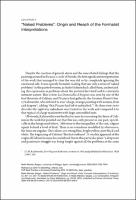Chapter “Naked Problems”. Origin and Reach of the Formalist Interpretations
| dc.contributor.author | Méndez Baiges, Maite | |
| dc.date.accessioned | 2022-12-22T16:07:47Z | |
| dc.date.available | 2022-12-22T16:07:47Z | |
| dc.date.issued | 2022 | |
| dc.identifier | ONIX_20221222_9788855186568_88 | |
| dc.identifier.issn | 2704-5919 | |
| dc.identifier.uri | https://library.oapen.org/handle/20.500.12657/60426 | |
| dc.description.abstract | The first solid interpretation of the damsels to make a mark was delivered from formalist criteria. Thus, as far as was possible the content of the work was disregarded, studying only in great detail all its pictorial or purely plastic values that proclaimed the great avant-guard revolution: the substitution of the Renaissance visual order with the modern visual order. From this point of view the Demoiselles appear as the seed of one of the most relevant avant-guard movements —Cubism. This chapter deals with the origin and how the formalist version shaped the painting —and Modern Art itself (from the 1920s until approximately the 1960s). | |
| dc.language | English | |
| dc.relation.ispartofseries | Studi e saggi | |
| dc.subject.classification | thema EDItEUR::A The Arts | en_US |
| dc.subject.other | Modernism | |
| dc.subject.other | Demoislles d'Avignon | |
| dc.subject.other | Alfred H. Barr | |
| dc.subject.other | MoMA | |
| dc.subject.other | Daniel-Henry Kahnweiler | |
| dc.title | Chapter “Naked Problems”. Origin and Reach of the Formalist Interpretations | |
| dc.type | chapter | |
| oapen.identifier.doi | 10.36253/978-88-5518-656-8.04 | |
| oapen.relation.isPublishedBy | bf65d21a-78e5-4ba2-983a-dbfa90962870 | |
| oapen.relation.isbn | 9788855186568 | |
| oapen.series.number | 242 | |
| oapen.pages | 8 | |
| oapen.place.publication | Florence |

